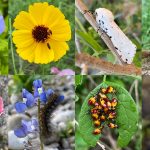Let’s not be so quick to judge the humble weed. After all, they are green, native and an important part of a diverse, stable ecosystem.
We have been blessed recently with plenty of rain to make everything grow lush and green. Of course, with all this extra time staying home and working from home, we find ourselves gazing upon our lush, green yard — of weeds.
But let’s not be so quick to judge the humble weed. After all, weeds are green, natural and an important part of a diverse, stable ecosystem. And they’re certainly resilient. In fact, a few of our experts have written about the benefits of weeds (don’t laugh, there are some).
Gail Gallegos discussed at length about when “To Weed or Not To Weed” and even has a helpful video on the subject. Cleve Powell introduced us to common weeds that are blooming now and how they’re important to pollinators. And both Sarah Gorton and I have sung the praises of horse herb and how it is an ideal alternative to turf grass.
If you still insist on eliminating these native, resilient plants, here are a few tips and tricks to try.
- While the soil is moist, pull firmly and consistently on the weed to remove as much of the root as possible. If tug too quickly, you’ll break the root and the weed will regrow.
- Spread a layer of mulch over the weeds to smother them and make it easier to pull them out.
- Try this simple recipe for a natural, effective way to kill weeds. This is a non-selective herbicide so protect non-target plants with cardboard or plastic.
- Prevent the germination of warm season weeds now with an even layer of corn gluten meal. It prevents the germination of many weeds, but also wildflowers so avoid using in areas you want wildflowers to bloom in the fall or following spring.
Regardless of which method you choose, have patience and keep after it. Persistence does pay off.




